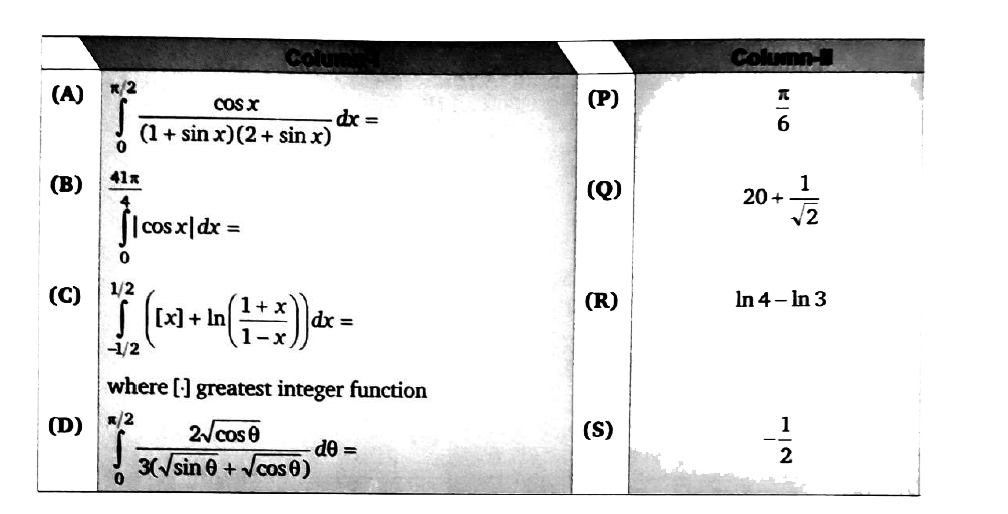Let f(x) be a non constant twice differentiable function defined on (−∞,∞) such that f(x)=f(1−x) and f'(14)=0. Then
2
3
4
5
The correct Answer is:C
Step by step video solution for Let f(x) be a non constant twice differentiable function defined on (-oo,oo) such that f(x)=f(1-x) and f'(1/4)=0. Then by Maths experts to help you in doubts & scoring excellent marks in Class 12 exams.
Updated on:21/07/2023Topper's Solved these Questions
- INDEFINITE AND DEFINITE INTEGRATIONBook:VIKAS GUPTA (BLACK BOOK) ENGLISHChapter:INDEFINITE AND DEFINITE INTEGRATIONExercise:EXERCISE (MATCHING TYPE PROBLEMS)
Explore 3 Videos
- INDEFINITE AND DEFINITE INTEGRATIONBook:VIKAS GUPTA (BLACK BOOK) ENGLISHChapter:INDEFINITE AND DEFINITE INTEGRATIONExercise:EXERCISE (SUBJECTIVE TYPE PROBLEMS)
Explore 27 Videos
- INDEFINITE AND DEFINITE INTEGRATIONBook:VIKAS GUPTA (BLACK BOOK) ENGLISHChapter:INDEFINITE AND DEFINITE INTEGRATIONExercise:EXERCISE (ONE OR MORE THAN ONE ANSWER IS/ARE CORRECT)
Explore 16 Videos
- HYPERBOLABook:VIKAS GUPTA (BLACK BOOK) ENGLISHChapter:HYPERBOLAExercise:Exercise-4 : Subjective Type Problems
Explore 3 Videos
- INVERSE TRIGONOMETRIC FUNTIONS Book:VIKAS GUPTA (BLACK BOOK) ENGLISHChapter:INVERSE TRIGONOMETRIC FUNTIONS Exercise:Exercise-5 : Subjective Type Problems
Explore 5 Videos
Similar Questions

View Solution∫x+(cos−13x)2√1−9x2dx=1k1(√1−9x2+(cos−13x)k2)+c, then k21+k22= (where C is an arbitrary constnat. )
View Solution∫dx(1+√x)8=−13(1+√x)k1+27(1+√x)k2+C, then:
View SolutionLet y=mx+c be a common tangent to x216−y29=1andx24+y23=1, then find the value of m2+c2.
View SolutionThe complete set of values of x satisfying the inequality sin−1(sin5)>x2−4x is (2−√λ−2π,2+√λ−2π), then λ=
View SolutionLet f(x) be a non-constant twice differentiable function defined on (oo,oo) such that f(x)=f(1-x) and f'(1/4)=0^(@). Then
View SolutionLet f:[4,∞)→[4,∞) be defined by f(x)=5x(x−4).Then f−1(x) is
View SolutionLet f:(−∞,2]→(−∞,4] be a function defined by f(x)=4x−x2. Then, f−1(x) is
View SolutionLet f(x)<0∀x∈(−∞,0)andf(x)>0∀x∈(0,∞) also f(0)=0, Again f'(x)<0∀x∈(−∞,−1)andf'(x)>∀x∈(−1,∞) also f'(−1)=0 given limx→∞f(x)=0andlimx→∞f(x)=∞ and function is twice differentiable.
The minimum number of points where f'(x) is zero is:
View SolutionLet f (x) be a twice differentiable function defined on (−∞,∞) such that f(x)=f(2−x)andf'(12)=f'(14)=0. Then
∫1−1f'(1+x)x2ex2dx is equal to :
View SolutionLet f:(0,∞)→R be a differentiable function such that f'(x)=2−f(x)x for all x∈(0,∞) and f(1)≠1. Then-
View SolutionLet f(x) be a twice differentiable function in (−∞,∞) such that f''(x)<0∀x∈R, g(x)=f(x)+f(1-x) and g'((1)/(4))=0 then
View SolutionLet a function f:(0,∞)→[0,∞) be defined by f(x)=∣∣∣1−1x∣∣∣. Then f is
View Solutionमाना f(x) एक अचरेतर (non-constant), दो बार अवकलनीय फलन है जो (−∞,∞) पर इस प्रकार परिभाषित है कि f(x)=f(1−x) तथा f'(14)=0 है, तब -
View SolutionLet f (x) be a twice differentiable function defined on (−∞,∞) such that f(x)=f(2−x)andf'(12)=f'(14)=0. Then
∫1−1f'(1+x)x2ex2dx is equal to :
View SolutionLet f(x) be a non-constant twice differentiable function defined on (−∞,∞) such that f(x)=f(1−x)andf′(14)=0. Then
View Solution
